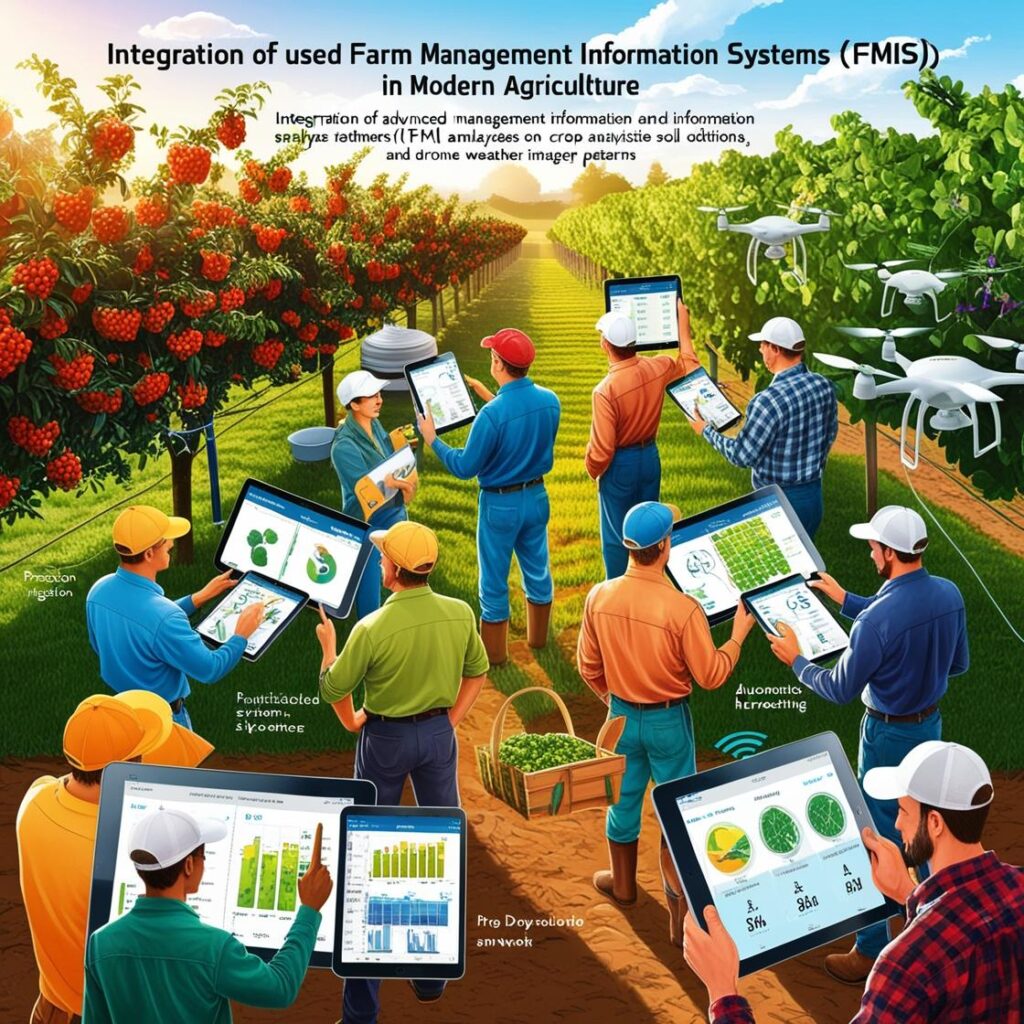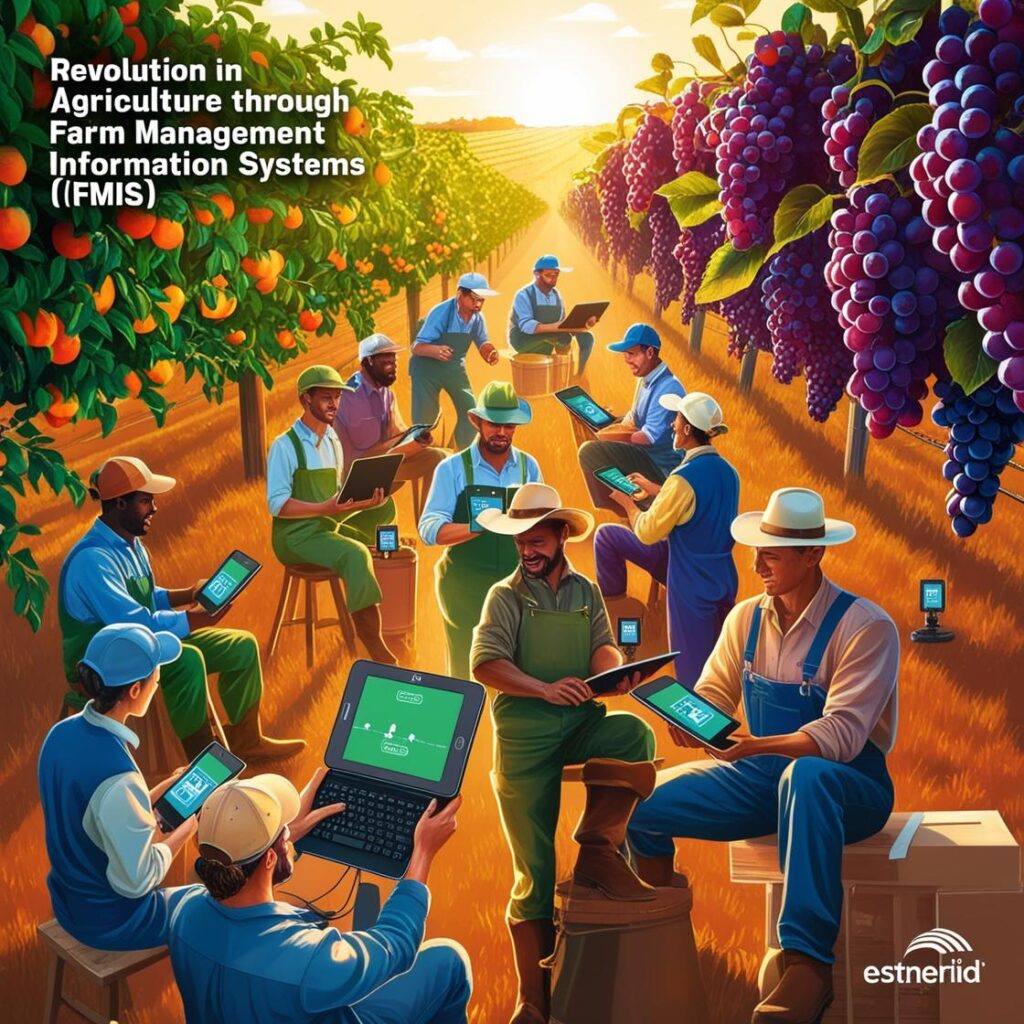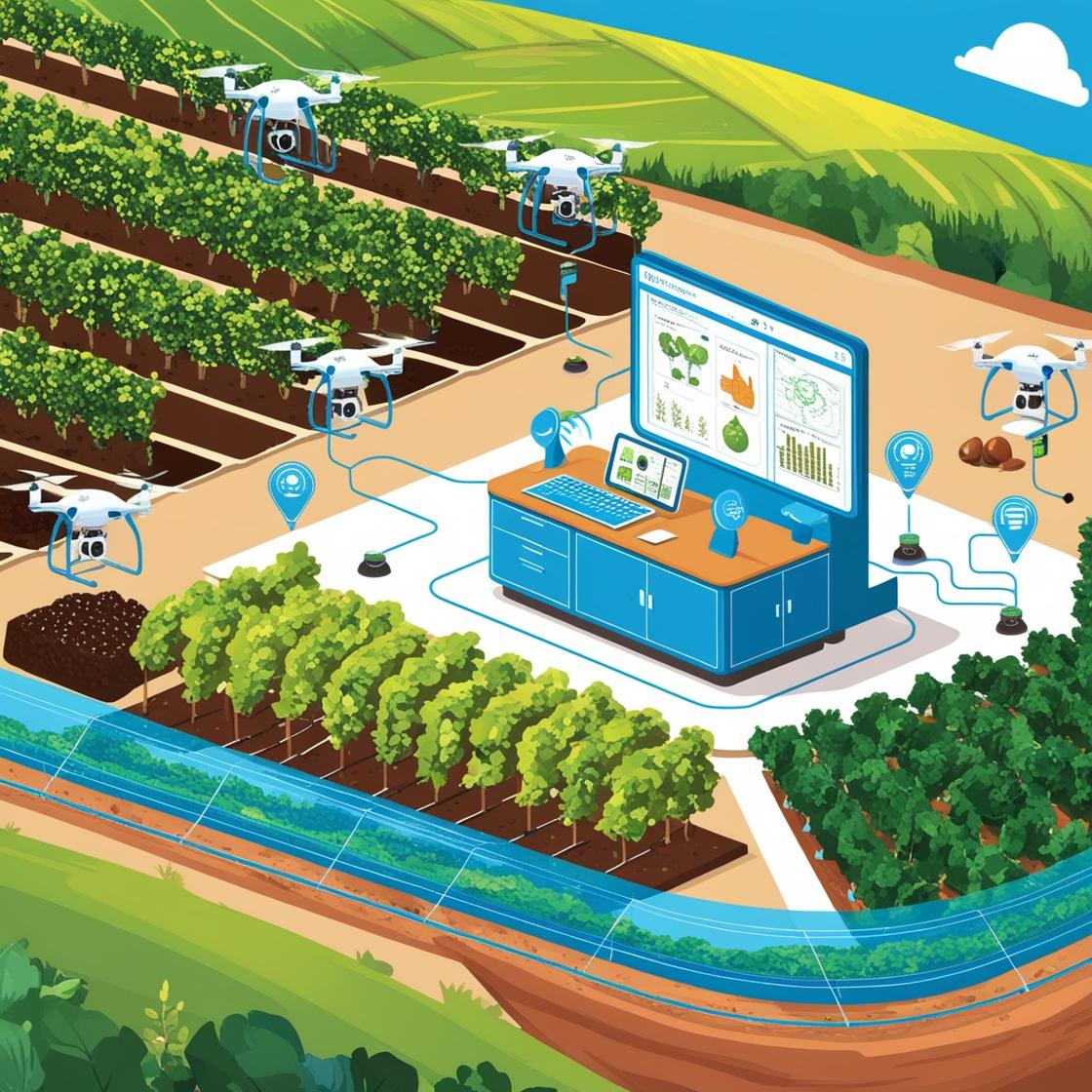In today’s ever-evolving agricultural landscape, farmers face an unprecedented array of challenges, from climate change to market demands. With the surge of digital innovation, Farm Management Information Systems (FMIS) have become essential tools for managing the intricate demands of modern farming. These advanced systems integrate real-time data collection and decision-making tools to make farms more productive, sustainable, and efficient. Here, we’ll break down the emerging technologies and FMIS techniques that are transforming agriculture, highlighting their applications and potential for orchard and vineyard management.

1. Understanding Farm Management Information Systems (FMIS)
Farm Management Information Systems support farmers by simplifying data collection, processing, and storage to ensure that every farm operation is well-timed and optimized for efficiency. These systems bridge the gap between raw data and actionable insights, offering solutions tailored to different farming needs—from irrigation scheduling to pest control.
Key Benefits of FMIS:
- Enhanced Decision-Making: Provides insights from collected data, helping farmers plan tasks efficiently.
- Data Organization: Logs every operation, creating a systematic database for improved planning and execution.
- Accessibility: With commercial options like AgriWebb and FarmLogs, FMIS is now available to farms of varying scales.
2. Evolution of FMIS in Agriculture
FMIS has come a long way since the 1970s. Initially focused on basic record-keeping, FMIS today utilizes precise data from satellites, sensors, and GPS technologies. These advancements allow for selective treatment of crops based on specific needs, moving away from a “one-size-fits-all” approach.
- Precision Agriculture: The late 2000s saw the rise of precision agriculture (PA), enabling data-driven crop management based on field variability.
- Specialized Software: Today’s systems handle everything from irrigation to pest management, making them invaluable for crop-specific needs.
3. Applications of FMIS for Orchards and Vineyards
Specialty crops like orchard fruits and grapes require high precision for optimal yield and quality. Here’s how FMIS supports their unique needs:
3.1 Pest Control and Management
- Precision in Pest Control: FMIS tracks disease patterns, enabling accurate pest management to protect human health and the environment.
- Data Logging: Advanced machinery records every pesticide application, creating a farm calendar for full product traceability.
3.2 Irrigation Management
- Optimized Water Usage: FMIS evaluates soil moisture, temperature, and other factors for well-timed irrigation, preserving water resources.
- Precision Solutions: Programs like USERPA focus on precision irrigation, particularly vital in orchards and vineyards where quality depends on precise water management.
3.3 Harvesting
- Accurate Harvest Timing: These systems offer real-time data, ensuring fruits are picked at optimal ripeness, boosting market quality.
- Yield Mapping: For large orchards, FMIS generates yield maps that help farmers understand productivity and refine harvest plans.
4. The Big Data Revolution in Agriculture
The concept of “Big Data” has reshaped modern agriculture by providing a comprehensive view of all farming operations. From soil quality to crop yield, Big Data offers actionable insights for farmers looking to optimize performance. Big Data can be characterized by several core attributes:
- Volume: Massive data collection from sensors and satellites.
- Velocity: Real-time data flow enables timely decision-making.
- Variety: Incorporates diverse data types, from temperature readings to yield statistics.
- Veracity: Ensures data reliability and accuracy for informed choices.
Actionable Tips:
- Start Small: Implement an FMIS for one or two processes to gradually integrate data management without overwhelming operations.
- Focus on ROI: Target areas where FMIS can directly impact profitability, like irrigation management, before scaling across other operations.
5. Leveraging FMIS and Big Data for Sustainable Agriculture
With the integration of FMIS and Big Data, agriculture is more poised than ever for sustainable growth. By improving water and pest management, minimizing waste, and optimizing productivity, these systems support long-term agricultural health.
Key Takeaways for Farmers:
- Adoption is Key: Younger, tech-savvy farmers are at an advantage; however, every farmer can benefit from simplified and automated record-keeping.
- Profitability and Sustainability: FMIS is not just an investment in efficiency but a tool for financial and environmental sustainability.
Conclusion: Key Points for Reels and Infographics
- Introduction to FMIS: Essential tool for data-driven decisions and sustainable farm management.
- Evolution: From basic record-keeping to precision agriculture.
- Applications: Pest control, irrigation, and harvest management for orchards and vineyards.
- Big Data in Agriculture: Characterized by Volume, Velocity, Variety, and Veracity.
- Sustainable Growth: FMIS supports efficient, profitable, and eco-friendly farming practices.
By embracing FMIS and leveraging Big Data, modern farmers can take control of their operations like never before, paving the way for a future where agriculture thrives both economically and ecologically.
This excerpt provides a thorough examination of the role of Big Data in agriculture, specifically how digital technologies and data analytics support decision-making and operational efficiencies in farming. Here’s a summary:
Sensing and Monitoring in Agriculture
The digital revolution enables precision agriculture by leveraging technologies such as GPS, remote sensing, AI, machine learning, robotics, and IoT. Data collected from field sensors (soil, weather), aerial sources (drones, satellites), and mobile-based crowdsourcing are critical in enhancing productivity and sustainability.
Challenges in Big Data Utilization for Agriculture
The diversity, fragmentation, and heterogeneity of data in agriculture pose significant challenges. Data errors and low-quality analytics often limit the effectiveness of farm management systems. Integrating this data into comprehensive management systems could improve accuracy and utility.
Data Management in Precision and Smart Farming
Precision agriculture initially aimed to adapt farming practices to specific conditions in each part of a field, but advancements have led to “smart farming,” which integrates broader situational awareness. Technologies like cloud-based management information systems (MIS) facilitate real-time data collection, storage, and analysis. Big Data frameworks, including Hadoop and Apache Spark, provide the infrastructure for managing vast agricultural data with efficiency.
Big Data Analytics in Agriculture
Big Data analytics involves steps such as data identification, collection, preprocessing, analysis, and interpretation. Each step involves selecting appropriate data types, removing irrelevant or incorrect data, and applying analytics methods like machine learning, clustering, and neural networks to derive actionable insights. These insights aid in decision-making on weather predictions, crop yield forecasting, pest control, and pricing models.
The potential of Big Data is maximized when it’s transformed into valuable insights that drive strategic farming decisions. Machine learning methods, including neural networks and clustering, have particular applications in forecasting and precision tasks, such as disease management, yield estimation, and resource allocation.
Let me know if there’s a specific aspect you’d like to explore or need further clarification on!
Machine Learning (ML) is a field of artificial intelligence (AI) that enables computers to learn and make decisions without explicit programming. It plays a critical role in leveraging Big Data by constructing algorithms that can extract insights and predict future outcomes. ML’s two-step process involves learning from input data and then analyzing input-output data relationships, which ultimately helps in building predictive models.



Types of Machine Learning Algorithms
ML algorithms fall into three main categories:
- Supervised Learning (SL): Here, both input and output data are available, guiding the algorithm to understand the relationship between them through labeled data. Supervised learning is often used for:
- Regression: Aims to predict continuous outputs, such as forecasting downy mildew disease in vineyards based on humidity levels.
- Classification: Involves predicting discrete outputs (e.g., classifying leaves as healthy or diseased) using features like color and shape to distinguish between different classes.
- Unsupervised Learning (UL): Only input data is provided, with no associated output labels. Techniques like clustering (K-means) allow algorithms to group similar data points, useful for detecting patterns and anomalies in large datasets, such as differentiating between soil types.
- Reinforcement Learning (RL): This focuses on decision-making by learning from rewards and penalties. Widely applied in robotics and gaming, RL enables systems to improve over time by learning from their actions’ feedback.
Additionally, Deep Learning (DL), a subset of ML, uses neural network models that mimic brain-like structures, excelling in feature extraction and prediction accuracy.
Applications in Agriculture
ML has transformative applications across several agricultural domains:
- Crop Management: Yield prediction, disease detection, and quality assessment are key areas. For instance, ML models analyze factors like soil composition and environmental data to predict crop yields or detect early-stage plant diseases.
- Water Management: By analyzing historical climate data, ML models estimate evapotranspiration and guide irrigation schedules.
- Soil Management: ML enables efficient mapping and analysis of soil properties, optimizing nutrient and water use.
Decision Support Systems (DSS) in Agriculture
Agricultural DSS use real-time and historical data to provide farmers with actionable insights for decision-making. Components of an effective DSS include:
- Data Collection and Integration: Field data (crop parameters, soil, climate) are gathered through sensors and manual input.
- Data Analysis and Processing: The data is processed using crop models that predict growth based on environmental conditions.
- Actionable Recommendations: Based on the analysis, DSS may advise on planting dates, harvest timing, irrigation schedules, and pest control.
Future DSS improvements aim to integrate holistic, user-friendly, and customizable solutions that better align with real-time decision-making needs in agriculture, thereby supporting farmers in maximizing productivity and minimizing resource waste.

1. Irrigation DSS
- Regulated Deficit Irrigation (RDI): Used to manage water by reducing irrigation at specific crop stages to control shoot growth. Effective in fruit orchards, though it poses a risk for drought-sensitive crops.
- Applications: Systems like CropSyst help prevent over-stressing crops under RDI, and GIS-based Spatial DSS (SDSS) offer precision management by combining environmental and crop data for orchard-specific irrigation.
2. Fertilization DSS
- Optimization of Fertilizer Use: Ensures optimal nutrient levels to maximize crop productivity and avoid economic and environmental downsides of over-fertilization.
- Applications: Based on extensive crop fertilization experiments, these DSS calculate ideal fertilizer doses, improving nitrogen efficiency and farm management.
3. Pest Management DSS
- Integrated Pest Management (IPM): Provides advanced planning for pest control, based on data on pest spread and environmental conditions, allowing precise timing and application of treatments.
- Applications: Pest DSS prevent unnecessary agrochemical use by offering data-driven decision-making for accurate pest control.
4. Examples of DSS in Agriculture
- DSSAT (Decision Support System for Agrotechnology Transfer): A software suite that models crop growth and soil conditions for various crops, supporting comprehensive crop management.
- Vineyard-Specific DSS: Systems like Vite.net and GeoVit focus on sustainable vineyard management, with real-time monitoring of conditions and alerts. Other platforms like VineSens and NAV use wireless networks and sensors to support pest and disease management in vineyards.
5. Farm Management Information Systems (FMIS)
- Overview: FMIS combines Big Data, sensing, data processing, and decision-making tools to streamline farm operations. This includes real-time monitoring and advanced analytics integrated into mobile apps for real-time data transfer, enabling farmers to make informed decisions year-round.
These DSS frameworks help manage various aspects of agriculture, from water conservation to pest and disease management, enhancing productivity and sustainability through precise and informed decision-making.

About Us
Welcome to Agriculture Novel, your go-to source for in-depth information and insights into the world of agriculture, hydroponics, and sustainable farming. Our mission is to educate, inspire, and empower a new generation of farmers, hobbyists, and eco-conscious enthusiasts. Whether you’re interested in traditional farming practices or modern innovations, we aim to provide comprehensive guides, expert tips, and the latest updates in agriculture and urban farming.
At Agriculture Novel, we believe in the power of knowledge to transform the way we grow, sustain, and nourish our world. Explore our articles on topics like Fruit Growing Guide, Hydroponics, Plant Deficiency Guide, and more.
Thank you for joining us on this journey towards a greener, more sustainable future!
About Agronique Horizon
At Agronique Horizon, we specialize in delivering comprehensive digital marketing and web development solutions tailored for the agriculture and hydroponics industries. From custom website design and app development to social media management, we provide end-to-end support for brands aiming to make a meaningful impact. Our team also offers innovative solutions for the real estate sector, bringing precision and visibility to your projects. Learn more about our services here and discover how we can elevate your digital presence

